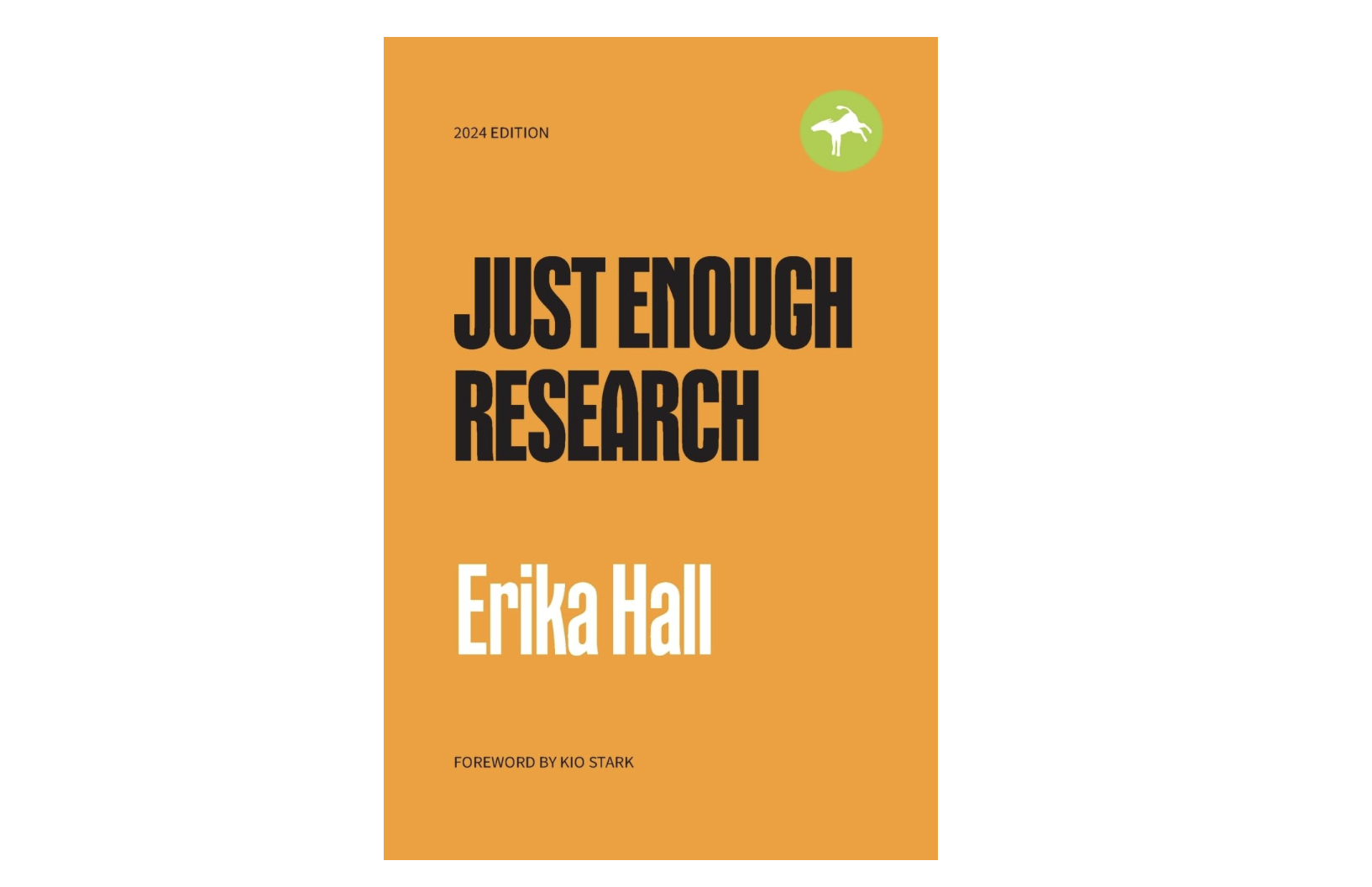Just Enough Research is highly relevant for courses in Quantitative and Qualitative Research, as it bridges academic principles with real-world application in design and business contexts. The book highlights how both research approaches can be used flexibly and effectively to uncover user needs, challenge assumptions, and support evidence-based decision-making.
Research doesn't have to be complicated
Have you ever felt overwhelmed by the idea of conducting research? Whether you're a student, designer, or business professional, Just Enough Research by Erika Hall makes the case that research doesn’t have to be an intimidating, expensive, or time-consuming process. Instead, it should be practical, efficient, and, most importantly, useful.
I picked up this book expecting a dry manual on research methods. What I found instead was a witty and no-nonsense guide that made me rethink how we approach research in everyday life.
Hall puts the spotlight on design research, which she sees as a broad term with a long backstory. In the 1960s, it was mainly about studying design itself; what it’s for, how it works, that kind of thing (Hall, p. 5). But what really sticks with me is her simple reminder that design always happens in context, and research is just about understanding that context (Hall, p. 22). That’s what makes her book stand out as it’s not caught up in abstract theory. It’s about practical, applied research that actually helps solve real problems.
She simplifies the concept early on, stating:
“Research is simply systematic inquiry. You want to know more about a particular topic, so you go through a process to increase your knowledge.” (Hall, p. 5)
Hall breaks down research into digestible, real-world case studies, emphasizing that anyone on a Content Team can benefit from learning how to gather and interpret information effectively.
6 Key Takeaways from Just Enough Research #
1. Research is all about asking the right questions
One of the book’s biggest strengths is its emphasis on moving beyond surface-level feedback. People often assume that research is just about gathering opinions, but Hall challenges this misconception:
“Research is not asking people what they like. As you start interviewing people involved in business...‘Like’ is not a part of the critical thinker’s vocabulary...It is a superficial and self-reported mental state unmoored from any particular behavior.” (Hall, p. 7)
Instead of asking what people like, Hall suggests focusing on how they behave, what they need, and why they make decisions.
2. Research requires a scientific mindset
Hall makes a solid point that good research isn’t about proving yourself right, it’s about staying genuinely curious. She puts it clearly: “Your desire to find out needs to be stronger than your desire to predict... You need to be able to depersonalize the work... You need to be a good communicator and a good analytical thinker” (Hall, p. 19). It’s a mindset shift. Research, especially the applied kind she’s talking about, isn’t about chasing confirmation, it’s about being open, asking questions and trying to understand what’s really going on.
3. Assumptions are the enemy of good research
One of the biggest pitfalls in research is assuming we already know the answers. Hall warns:
“Familiarity breeds assumptions and blind spots.” (Hall, p. 20)
When we assume too much, we risk designing for ourselves instead of the actual users. This is why research is crucial as it reveals blind spots and uncovers the real challenges people face.
4. Research and design are cyclical, not linear
Hall reminds us that research doesn’t stop after one round of data collection, it’s an ongoing process. She explains:
“Design is an iterative process. Questions will continue to crop up. Some of them you can answer with research and some you can only answer with design.” (Hall, p. 36)
This is a crucial insight for designers, marketers, and product teams, great solutions come from a cycle of research, testing, and refinement.
5. Base your statements on a verb
One of the most practical takeaways from the book is how to frame research questions effectively. Hall advises:
“In design, you’re solving for user needs and business goals. In research, you’re solving for a lack of information...So base your statement on a verb that indicates an outcome, such as ‘describe,’ ‘evaluate,’ or ‘identify’... Avoid using open-ended words like ‘understand’ or ‘explore.’” (Hall, p. 38)
This is a game-changer for students and professionals alike as the way you phrase your research question shapes the kind of answers you’ll get.
6. Take a simple, six-step approach to research
One of the most useful aspects of the book is its straightforward approach to conducting research. Hall breaks it down into six essential steps:
“Whatever type of research you’re doing, and wherever it falls in your schedule, follow these six steps:
- Define the problem.
- Select the approach.
- Plan and prepare for the research.
- Collect the data.
- Analyze the data.
- Report the results.” (Hall, p. 37)
This structured yet flexible framework makes research feel doable. It’s a clear, grounded way to move from uncertainty to insight.
Overall, Hall’s work is a reminder that research doesn’t have to be intimidating or overly academic. At its core, it’s about asking the right questions, staying curious, and making sense of the world around you.
Where to go from here #
References #
Hall, E. (2024). Just enough research (2024 ed.). Mule Books.

